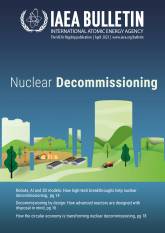As more countries embrace nuclear power to improve energy security and mitigate climate change, the challenge of successfully decommissioning nuclear facilities is set to grow. A crucial factor in meeting that challenge is to address it up front.
Today, 56 reactors are under construction worldwide, and many countries are putting into motion plans to expand their nuclear fleet or build their first nuclear power programme.
When it comes to the end of life of a nuclear reactor, forethought and innovation today play pivotal roles. New nuclear power plants, including those with small modular reactors (SMRs), are being designed with their decommissioning in mind. In other words, designers are planning how their nuclear power reactors will be dismantled even before construction begins.
The IAEA has a unique global role in facilitating the adoption of emerging nuclear technologies, coupled with greater harmonization of regulations to enable safe and efficient decommissioning when the time comes.
Almost half of the 423 nuclear power reactors the world relies on today are expected to enter the decommissioning process by 2050. Each one could take up to 20 years or more to fully decommission.
The IAEA assists countries in ensuring that decommissioning work is carried out within the appropriate technical and regulatory frameworks, by promoting safety standards and good international practices through workshops, forums, missions and publications.
Decommissioning reflects a responsibility and commitment to a circular industrial and nuclear cycle. More material is being recycled, while cost savings are being made and timeframes condensed. Meanwhile, new technologies such as data science, artificial intelligence, robotics and drones are bringing greater effectiveness and safety to decommissioning activities.
The IAEA ensures lessons and innovations from successful decommissioning projects are shared, including through our International Decommissioning Network. It also plays a vital role ensuring safety, even under challenging circumstances. The Fukushima Daiichi nuclear accident in 2011 required innovations, such as the use of cosmic-ray muon mapping to help locate the damaged fuel and the building of a frozen subterranean wall to prevent groundwater seeping into contaminated water inside the reactor buildings, as well as the use of robotics for work in areas with limited access. These innovations helped boost effectiveness and efficiency while minimizing the danger to workers, the general public and the surrounding environment.
Safety is crucial, but it is not the only consideration. Safeguards are key to the decommissioning process. IAEA inspectors are on hand when spent fuel is moved or disposed of to verify that materials used in nuclear plants are not diverted from
peaceful use.
International cooperation and knowledge sharing supported by the IAEA are vital to meeting the growing global demand for nuclear decommissioning. It is important to get the back end of the nuclear fuel cycle right so that nuclear can play a full and sustainable role in addressing the world’s most pressing challenges, from mitigating climate change and air pollution to providing energy security and the nuclear medicine needed to fight cancer and heart disease.



